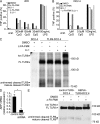Nucleic acid recognition by Toll-like receptors is coupled to stepwise processing by cathepsins and asparagine endopeptidase
- PMID: 21402738
- PMCID: PMC3135342
- DOI: 10.1084/jem.20100682
Nucleic acid recognition by Toll-like receptors is coupled to stepwise processing by cathepsins and asparagine endopeptidase
Abstract
Toll-like receptor (TLR) 9 requires proteolytic processing in the endolysosome to initiate signaling in response to DNA. However, recent studies conflict as to which proteases are required for receptor cleavage. We show that TLR9 proteolysis is a multistep process. The first step removes the majority of the ectodomain and can be performed by asparagine endopeptidase (AEP) or cathepsin family members. This initial cleavage event is followed by a trimming event that is solely cathepsin mediated and required for optimal receptor signaling. This dual requirement for AEP and cathepsins is observed in all cell types that we have analyzed, including mouse macrophages and dendritic cells. In addition, we show that TLR7 and TLR3 are processed in an analogous manner. These results define the core proteolytic steps required for TLR9 function and suggest that receptor proteolysis may represent a general regulatory strategy for all TLRs involved in nucleic acid recognition.
Figures





References
Publication types
MeSH terms
Substances
Grants and funding
LinkOut - more resources
Full Text Sources
Other Literature Sources
Molecular Biology Databases

